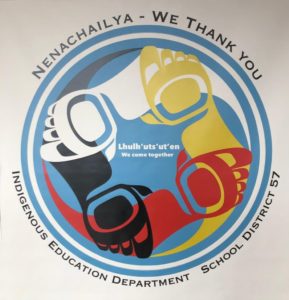Lhulh’uts’ut’en (We Come Together)
VIRTUAL Indigenous Professional Development Day
September 25, 2020
Permission from artist Timothy Foster to use picture below

THE WHAT
What I have learned the most at the September 25 Professional Day (as a common theme) and being in the Education program is the importance of ally-building between non-Indigenous and Indigenous peoples within the context of Indigenous education. As a teacher, it is critical that we model and value Indigenous knowledge, history, and cultures to ensure that non-Indigenous students understand and better appreciate the importance of learning about Indigenous perspectives. As teachers, it is imperative to position ourselves as learners, messaging things like, “we are going to learn about this together.” The same holds true for Indigenous teachers learning and teaching about different Indigenous cultures.
The Calls to Action of the Truth and Reconciliation Commission (TRC) of Canada (TRC, 2015a), guided by the Anishinaabemowin language, the Medicine Wheel, and the Seven Grandfather Teachings, summarizes my above paragraph nicely: what we can do to move from niinwi, “we but not you,” and kiinwa, “you all but not us,” to kiinwi, “you and us (together).”
I found that throughout the sessions, there were also common themes such as the importance of gaining a deeper understanding of identity as well as gaining a deeper awareness of personal biases. Inner reflections on our practice expands our experiences to include diverse perspectives on people and cultures to create equity. This occurs through structured dialogue and conversations that count, engaging ourselves and our students to think in ways that has meaning to us and our connections – the relationships we build and sustain as teachers.
I was very happy to attend the session on Nusdeh Yoh School. Being a former educational assistant at that school, I have learned so much about that school, what defines it as an Indigenous Choice school, and how their approaches to academic achievement, language and culture engages all students and their students on learning Indigenous perspectives. Their approaches encompass experiential learning, connected to circle, Dakelh language, the medicine wheel, the Lheidli T’enneh Seasonal Rounds Calendar, drumming and, restitution and restorative practice.
The session on circle reinforced for me something I knew, however appreciated the reinforcement that circles are an essential process for building relationships, resolving social problems, and responding when harm occurs. Circles create a positive learning environment, which then creates a positive climate in our schools.
SO WHAT
Reconciliation, the process of moving from niinwi and kiinwa to kiinwi is the SO WHAT. This shift needs an “all hands on deck” approach where collectively, we (teachers, students, families, communities) all embrace and fully participate in acquiring the knowledge and understanding of Indigenous perspectives and worldviews. This needs a call to action in our schools, at home, and in our communities where we honour Indigenous peoples, their history, their cultures, and their. Although the classroom is a microcosm of this action, ally-building on an individual level in our classrooms leads to classroom community-building and the development of respectful, reciprocal relationships in our society and communities.
Reconciliation needs love. All of this must be done with love. When our students enter our classroom, regardless of their heritage, we love them all and ensure they all know they belong with us. Tis provides the space for students to develop and practice love with one another. As teachers, we must always remember that we guide the next generation and therefore have a huge impact on what this new generation will learn. This will need change – let’s be ready and excited for this journey!
NOW WHAT
I know wholeheartedly that I will continue to teach in ways that maximally honour our Indigenous peoples. I know that we must maintain and even enhance our connections with Indigenous peoples and their perspectives. In the months and years ahead, our educational system must increase our ability and our opportunities to bring Indigenous ways and their voices in our classrooms. This will mean bringing Elders in our classrooms, continuing to incorporate circles, learning about different languages, histories, traditions, and connecting with nature to appreciate our land.
Just a note: It would have been great to do the drumming in person, however fully realize the limitations that COVID-19 has placed on us. Despite being virtual, it was very engaging and well organized.
Thank you everyone for this wonderful day of learning – it did not disappoint!!
Reference
Truth and Reconciliation Commission of Canada (TRC). (2015a). Calls to action. Winnipeg, MB: Truth and Reconciliation Commission of Canada.